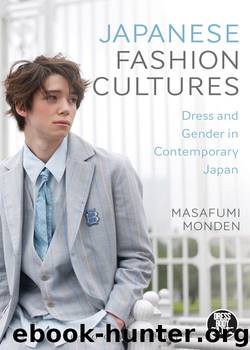Japanese Fashion Cultures by Monden Masafumi

Author:Monden, Masafumi.
Language: eng
Format: epub
ISBN: 9781472586728
Publisher: Bloomsbury UK
Published: 2014-08-08T04:00:00+00:00
In this sense, the concept of kawaii can operate like a feminine masquerade in Joan Riviere’s terms.123 According to McVeigh, women can use cuteness to their own advantage by obtaining favours and attention from those hierarchically above while their apparently ‘non-threatening’ manners might gain control over those who are their subordinates.124 This idea enables a reading that such a kind of cuteness displayed by the Japanese performers in their music videos might be telling of something more than a submissive, docile femininity. For example, through crafting the Alice look, these three performers manifest an implicit parody of Japanese female ‘idols’, which is a conceptual embodiment of the kawaii and shōjo aesthetics in Japanese popular culture.125 The most typical image associated with female pop idols, particularly in the 1970s and 1980s, is that of Miss Sweet and Innocent with a ballerina-like flared dress, an image largely believed to be manufactured and controlled by male producers.126 The dominant image of ‘idols’, moreover, were those who do not expect or are not expected to contribute to any creative or production process of their music.127
This has led Japanese female pop musicians, let alone Japanese pop music itself, to be seen by both Japanese and non-Japanese critics as lacking in authenticity. For those critics, authenticity is largely predicated on a do-it-yourself aesthetic and emphasis on creative control.128 However, paying particular attention to Miller’s theory of ‘feigned innocence’, I would argue that the music videos of Mizuki, Kawase and Kimura narrate three stages of kawaii specifically as a means to exercise creative control. While Mizuki’s Alice was still showing the influences of Japanese ‘idol’ images and her (or her managing agent’s) attempt to move away from them, Kawase and Kimura had careers performing in rock bands prior to their solo careers, and wrote most of their own lyrics. They have established themselves as songwriters, not ‘idols’, and their creative control over their repertoires allow them to embrace and parody the cute aesthetics freely.
Download
This site does not store any files on its server. We only index and link to content provided by other sites. Please contact the content providers to delete copyright contents if any and email us, we'll remove relevant links or contents immediately.
| Africa | Americas |
| Arctic & Antarctica | Asia |
| Australia & Oceania | Europe |
| Middle East | Russia |
| United States | World |
| Ancient Civilizations | Military |
| Historical Study & Educational Resources |
The Sympathizer by Viet Thanh Nguyen(4305)
The Rape of Nanking by Iris Chang(4136)
World without end by Ken Follett(3426)
Ants Among Elephants by Sujatha Gidla(3416)
Blood and Sand by Alex Von Tunzelmann(3138)
Japanese Design by Patricia J. Graham(3107)
City of Djinns: a year in Delhi by William Dalrymple(2511)
The Queen of Nothing by Holly Black(2489)
Foreign Devils on the Silk Road: The Search for the Lost Treasures of Central Asia by Peter Hopkirk(2431)
India's Ancient Past by R.S. Sharma(2414)
Inglorious Empire by Shashi Tharoor(2394)
Tokyo by Rob Goss(2388)
In Order to Live: A North Korean Girl's Journey to Freedom by Yeonmi Park(2343)
India's biggest cover-up by Dhar Anuj(2317)
Tokyo Geek's Guide: Manga, Anime, Gaming, Cosplay, Toys, Idols & More - The Ultimate Guide to Japan's Otaku Culture by Simone Gianni(2314)
The Great Game: On Secret Service in High Asia by Peter Hopkirk(2305)
Goodbye Madame Butterfly(2201)
Batik by Rudolf Smend(2123)
Living Silence in Burma by Christina Fink(2037)
